Final report for GNE18-164
Project Information
The Fourth National Climate Assessment Report (Figure 1) forecasts that extreme heat, drought, and heavy downpours will disrupt the daily operations of farmers and reduce yield (Herring et al., 2018; Jay et al., 2018; USGCRP, 2018). The scale in which climate change is expected to impact farmers and crop yield emphasizes the need to research farming practices that enhance tolerance to drought and flood (Wiebe et al., 2015). Long-term agricultural experiments comparing the effects of different farming practices on soil properties can provide an important blueprint by which the climate-adaptive management practices are determined.
The Farming Systems Trial (FST) at Rodale Institute (Rodale) in Kutztown, Pennsylvania is a 40-year long-term agricultural experiment comparing three farming management systems (organic manure, organic leguminous, and synthetic conventional). During drought years between 1989-1999, Rodale scientists observed soybean yield in organic plots at FST greater than conventional ones. This was generally attributed to greater water content and infiltration rates in organic plots (Lotter et al., 2003). Investigating saturated hydraulic conductivity and soil water retention in the organic plots at Rodale FST can help determine the processes behind the observed drought-resilient properties developed from organic management.

Soil samples were collected from Rodale FST at three different depth intervals (0 – 10, 10 – 20, 20 – 30 cm) and analyzed for soil hydraulic conductivity, water retention, bulk density, organic carbon, total nitrogen, and texture. Organic carbon, total nitrogen, and bulk density were used to estimate soil health and fertility. While saturated hydraulic conductivity was used to estimate soil drainage during floods (Blanco-Canqui et al., 2002), and water retention helped quantify crop moisture characteristics such as wilting point and plant available water (Kern, 1995).
Properties such as bulk density, organic carbon, total nitrogen, and plant available water were found to significantly vary by depth. On the contrary, saturated hydraulic conductivity was one of the few properties that did not significantly vary by depth. Management was found to have an observable direct effect on organic carbon, total nitrogen, and bulk density. However, agricultural management did not have a significant direct effect on plant available water at 0 – 10 and 20 – 30 cm or saturated hydraulic conductivity at 0 – 10 or 20 – 30 cm.
The largest variation in soil properties between management systems was strongly observable at the 10 – 20 cm interval, at this depth the organic manure (MNR) management was found to significantly increase organic carbon (+37%), total nitrogen (+20%), and reduce bulk density (-20%) when compared to the conventional (CONV) system. Organic manure (MNR) also increased saturated hydraulic conductivity (+36%) at 10 – 20 cm, although, ANOVA results showed a near significant variation in saturated hydraulic conductivity with treatments (p = 0.076).
When compared to the conventional system, leguminous organic (LEG) management was found to significantly increase organic carbon (+22%), total nitrogen (+13%), and reduce bulk density (-10%). Despite lack of statistical significance, mean plant available water was greater (+7%) in organic manure and leguminous management when compared to conventional management.
- Objective 1: Measure soil hydraulic conductivity and water retention properties in soil cores collected from organic manure, organic leguminous, and synthetic conventional crop management systems at the Rodale FST.
- Objective 2: Assess soil organic carbon and nitrogen content in organic manure, organic leguminous, and synthetic conventional crop management systems at the Rodale FST.
- Objective 3: Investigate the interactions between soil hydraulic properties, soil texture, and soil biogeochemical characteristics and determine the optimal practices that lead to increase drainage (saturated hydraulic conductivity) and drought resilience (increased plant available water).
Quantifying the extent to which organic farm management can create resilient agro-ecosystems is crucial for farmers and food security (Mäder et al., 2002; Power, 2010). The purpose of this project was to compare the soil water retention, saturated hydraulic conductivity, organic carbon, total nitrogen, and bulk density in organic manure organic, organic leguminous and synthetic conventional farm management system at the FST. These measurements can help determine which of the farming practices can improve soil health and develop drought resistance and flood resilience.
This project is unique because it analyzes soil samples from a well-documented long-term comparative agricultural experiment using cutting edge laboratory instruments. Instruments used in this study to characterize the soil water retention curve (Meter Group HYPROP and WP4C) and saturated hydraulic conductivity (Meter Group KSAT) produce a much wider range of data when compared to common analytical methods such as pressure plate extractors. Additionally, the project’s analysis of a well-documented long-term experiment (Rodale FST) in the Northeast guarantees that the findings from this study can be ultimately extrapolated to farms around the Northeast. Determining the extent to which sustainable and organic farming provides a practical and economically viable climate adaptation method this project will provide the blueprint for future farm and crop management recommendations.
Cooperators
- (Educator and Researcher)
- (Researcher)
- (Researcher)
Research
Study Site
The Farming Systems Trial (FST) is a long-term comparative agricultural management experiment located at the Rodale Institute in Kutztown, Pennsylvania, USA. FST is a split-plot randomized block experiment set on six hectares divided into 24 plots 92-meter-long by 18 meters (Figure 2 and Figure 3) (Seidel et al., 2017).
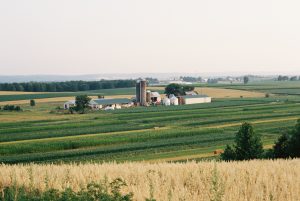
At the beginning of the experiment in 1981, FST had three original management systems replicated 8 times. The management systems included a conventional grain rotation in which mineral fertilizer and synthetic pesticides/herbicides were applied (CONV); an organic grain rotation that used leguminous cover crops such as hairy vetch and rye (LEG); and an organic animal-based grain rotation with composted cattle manure and cover crops (MNR) (Wander et al., 1994). All FST plots were regularly cultivated down to 5 cm for weed removal. A moldboard plow was used in the manure and leguminous organic plots while a chisel plow was used in the conventional ones. In 2008, half of the replicates for each treatment were converted to low-till or rotational low-till (NT), which were tilled at a lower frequency. This resulted in six management systems (MNR-T, MNR-NT, LEG-T, LEG-NT, CONV-T, CONV-NT) replicated four times.
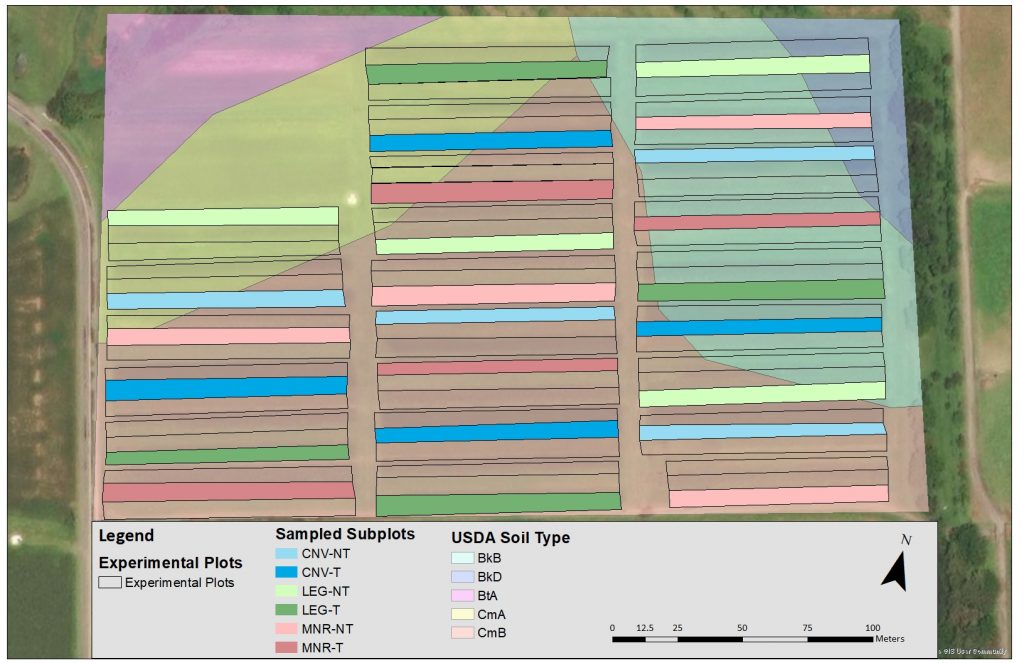
Sample Collection
Sample collection was conducted with great help and assistance from Rodale Institute researchers and research interns, graduate students from Rutgers University with the leadership of Dr. Daniel Gimenez, and students from Temple University with the leadership of Dr. Josh Caplan.
In June 2018, two main types of soil samples were collected from FST. Field samples (denoted as FIELD) consisted of soil collected to a depth of 30 cm using a soil probe (2.5-cm diameter) at ten spatially distributed locations in each plot. The probe samples were split at three different depth intervals (0 – 10, 10 – 20 and 20 – 30 cm) and then composited into one sample per depth per plot (24 plots at 3 depths) (Figure 4). Additionally, Core Samples (denoted as CORE) consisted of one intact metal core (8 cm diameter, 5 cm height) carefully extracted from the central crop row in each plot at the same three depth intervals (Figure 5). In total, 72 FIELD and 72 CORE samples were collected from FST (6 treatments, 4 experimental replicates, 3 depths). All samples were stored at 4°C until laboratory processing.
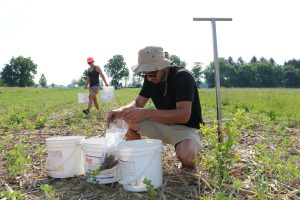
Collecting the samples from 0 – 10, 10 – 20 and 20 – 30 cm allowed us to determine the effects of treatment in the tillage mixing zone (0 – 20 cm, plow zone) and beyond the tillage mixing zone (20 – 30 cm). This should help determine if the effects of farm management exist beyond the mixing zone and if tillage frequency supplements organic management.
After collection and storage, FIELD samples were air-dried in the laboratory and sieved through a 2 mm sieve in order to remove rocks/pebbles/plant roots. Sieved dry samples (> 2 mm) were then ground up with a ball mill grinder, packed into tin capsules and analyzed for total carbon and total nitrogen in a Costech elemental analyzer. Replicates of the soil samples were packed into silver capsules, acidified with hydrochloric acid fumes and then run through the elemental analyzer for organic carbon and nitrogen. A comparison of the results from both analyses allowed us to confirm that Total Carbon results are reflective of Soil Organic Carbon.
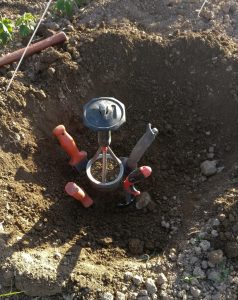
CORE samples were analyzed on the METER KSAT using the falling head method for saturated hydraulic conductivity, then the core was transferred to the METER HYPROP to collect soil water retention data using the evaporation method. Sub-samples from the HYPROP Intact cores were collected and analyzed on a dewpoint potentiometer (Decagon WP4C) to obtain soil water retention data points around the wilting point. After the analysis, the CORE samples were broken apart and sieved (> 2 mm). CORE Sub-samples were analyzed for particle size analysis using the pipette method, helping quantify the total sand (2000 – 50 µm), coarse (50 – 20 µm), medium (20 – 5 µm), and fine silt (5 – 2 µm), and coarse (2 – 0.2 µm) and fine clay (2 – 0.2 µm) content in each CORE. Another batch of CORE sub-samples were ground up and analyzed for Total Carbon and Total Nitrogen on the elemental analyzer.
Statistical Analysis
A one-way Analysis of Variance (ANOVA) with an α = 0.05 was used to determine if there are significant differences in the measured soil properties between each management system (organic manure, organic leguminous and conventional) or each depth interval (0 – 10, 10 – 20, and 20 – 30 cm). Following the ANOVA, a Pearson correlation was used to examine any associations between the measured soil variables.
Soil Texture Results
The primary textural class of the experimental plots (71 samples out of 72 samples) is silt loam (geometric mean of 22% sand, 60% silt, and 17% clay), with only one sample out of 72 samples at 20 – 30 cm being characterized as loam (27% sand, 46% silt, and 26% clay). USDA soil survey data shows the experimental site spatially covers two USDA soil series, with 18 plots out of 24 located within the Clarksburg series (denoted on Figure 3 as CmA and CmB) and the remaining 6 plots in the Berks-Weikert series (denoted on Figure 3 as BkB and BkD) (Figure 3).
Effect of Depth
In this study bulk density (p < 0.05), organic carbon (p < 0.05), total nitrogen (p < 0.05), plant available water (p < 0.05) were found to be significantly different by depth. However, the saturated hydraulic conductivity was not found to be significantly different by depth (p = 0.307).
Changes in soil properties across depth followed three distinct vertical patterns:
(1) Soil organic carbon and total nitrogen gradually decreased with depth, with the largest decrease occurring from 10 – 20 to 20 – 30 cm (Figure 6). This observation is common since organic carbon and total nitrogen in the tillage zone should be relatively uniform due to tillage mixing. Organic carbon and total nitrogen then tends to decrease exponentially beyond tillage mixing depth (0 – 20 cm) (Franzluebbers, 2005).
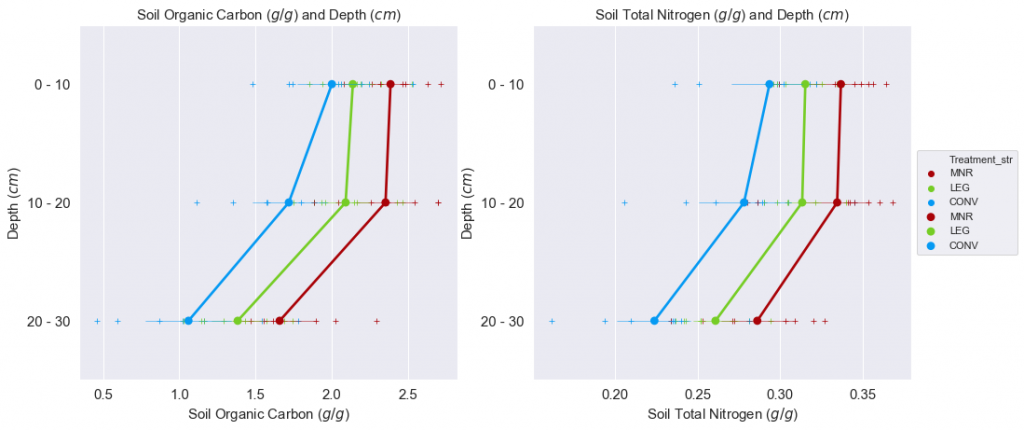
(2) Bulk density increased with depth, with the largest increase from 10 – 20 to 20 – 30 cm; The increase in bulk density is generally caused by a reduction in pore space, SOC, aggregation, and an increase in compaction (Figure 7).

(3) soil water retention variables such as plant available water (PAW) and wilting point increased from 0 – 10 to 10 – 20 and decreased from 10 – 20 to 20 – 30 cm (Figure 8).
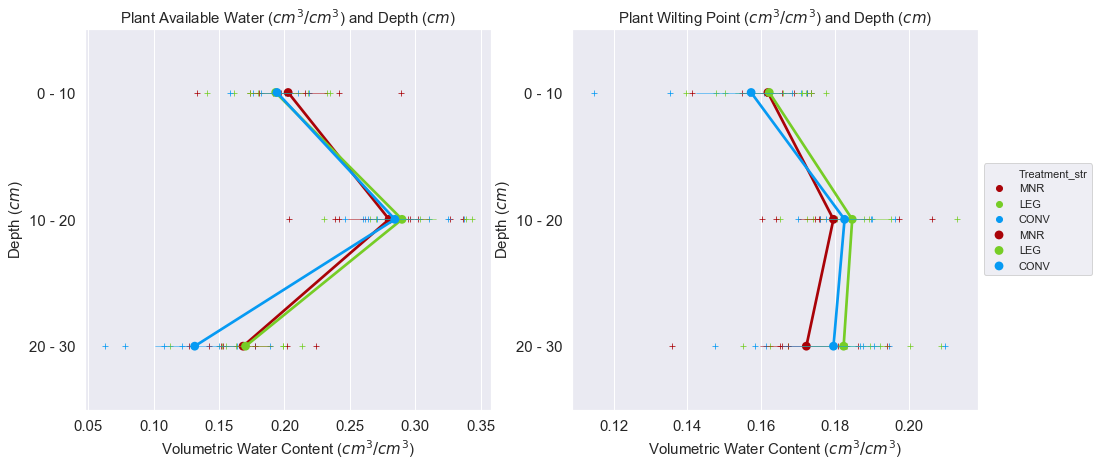
Effect of Treatment
Treatment had an observable direct effect on organic carbon, total nitrogen, and bulk density, but no direct effect on soil water retention properties at 0 – 20 cm or saturated hydraulic conductivity at 0 – 10 and 20 – 30 cm.
The organic manure management (MNR) had (+14%) and (+34%) increase in organic carbon when compared to organic leguminous (LEG) and conventional systems (CONV) respectively (observed in Figure 6). The significant increase in organic carbon in organic manure system mirrors previous studies that examined the effect of manure amendments on organic carbon (Gattinger et al., 2012; Blanco-Canqui et al., 2015) and follows historical FST results (Wander et al., 1994; Seidel et al., 2017). Total nitrogen was statistically different between treatments across all depths. When compared to the conventional system (CONV), organic manure (MNR) and leguminous (LEG) had a (+20%) and (+12 %) increase in total nitrogen respectively (observed in Figure 6). The largest value for total nitrogen was observed in organic manure (MNR) at 10 – 20 cm (0.368 g/g) and the smallest was in conventional (CONV) at 20 – 30 cm (0.162 g/g). Bulk density in organic manure (MNR) was (-16%) and (-8%) smaller when compared to organic leguminous (LEG) and conventional (CONV) (Figure 7).
Similar to other soil properties measured in this study, the greatest variation in saturated hydraulic conductivity between treatments (organic manure, organic leguminous, conventional) was observed at the 10 – 20 cm, while the smallest was at 20 – 30 cm. The organic manure management (MNR) had a (+10%) and (+18%) increase in saturated hydraulic conductivity when compared to organic leguminous (LEG) and conventional (CONV), highlighting the improved ability of manure management (MNR) to drain water when the soil is saturated (Figure 9).

- Organic management, whether it is manure or leguminous, leads to an increase in soil organic carbon and total nitrogen. That increase provides the soil microorganisms with increased energy sources and an increased supply of nitrogen. This can lead to a general improvement in soil fertility which is then observed to reduce bulk density and increase saturated hydraulic conductivity.
- Manure amendments tend to provide the best increase in soil properties (soil organic carbon, total nitrogen, saturated hydraulic conductivity), but also increases the complexity (or non-linearity) of the relationships between soil organic carbon and soil hydraulic/water retention properties. The correlations between measured soil properties in MNR have generally been weaker (less-linear and less-significant) when compared to LEG and CONV.
- The effects of management on soil hydraulic conductivity and soil water retention properties (plant available water) are depended on depth. For saturated hydraulic conductivity the effect of management is the closest to significance (p = 0.067) at 10 – 20 cm, where the manure system had the largest saturated hydraulic conductivity, followed by the leguminous then the conventional. This shows that organic management can lead to an increase in the drainage rate of the soil, which allows the farmland to be more resilient to large rainfall events.
- Similar to hydraulic conductivity, no statistically significant variability was found between treatments in plant available water (at 0 – 10 cm: p = 0.8, at 10 – 20 cm: p = 0.8). However, at 20 – 30 cm the difference in plant available water by treatment was near significant (p = 0.090). At this depth the manure organic system had (+28%) increase in plant available water while the leguminous had a (+29%) increase.
Education & Outreach Activities and Participation Summary
Participation Summary:
- May 2018 – August 2018: Research Internship at Rodale Institute.
As a research intern at the Rodale Institute between May and August 2018, field experience allowed me to comprehensively understand the complexity of our food and agricultural systems. I presented the objectives, proposed analyses and narrative of my research project to Rodale Researchers, ASC (Agriculturally Supported Communities) future farmers and Rodale staff. Each presentation was specifically prepared for the target audience to ensure clarity of information. The input and questions about the project were logged and documented to help me improve future outreach presentations after data analysis was completed. - January 7, 2019: Poster Presentation at Soil Science Society

Outreach Photograph Shared by UPenn Department of Earth and Environmental Science on Twitter.
International Soils Meeting. Linked Here. - February 28, 2019: Presentation at the Ravi Ecohydrology lab at Temple University.
- April 3, 2019: Graduate Seminar/Presentation at the Department of Environmental Sciences, Rutgers University.
- March 29, 2019: Poster Presentation at Graduate Research Conference, Department of Earth and Environmental Science University of Pennsylvania.
- May 23, 2019: Graduate Research Presentation at Rodale Institute.
- July 19, 2019: Rodale Field Day, Discussion of Results with farmers at FST.
- An article highlighting the narrative and objective of my research project was published here: https://rodaleinstitute.org/science/articles/assessing-drought-resistance-in-soils-managed-with-regenerative-organic-practices/
- Pictures captured by me during my internship on the Rodale Farm were published here:https://www.greenetwork.org/copy-of-alfahham-research
- Currently working on a manuscript for publication.
Project Outcomes
This project expanded upon the soil properties that we know can be affected by agricultural management in general, specifically organic management. In addition to previously known changes that occur in organically managed soil, such as the increase of soil organic carbon, total nitrogen, and reduction in bulk density. This project helped shed light on the depth specific increase in saturated hydraulic conductivity (mostly at 10 - 20 cm) and increase in plant available water below the 20 cm depth.
The same analyses (soil water retention using the evaporation method, saturated hydraulic conductivity using the falling head method) should be conducted on other long term experiments and at deeper depths in order to increase the breadth of datasets.
- One of the most eye-opening realizations is how variable agricultural management methods can be across geographies, climates and market forces. This makes it extremely hard to prescribe uniform management systems. Instead, small supplementary modification in a farmer's management, such as the addition of composted manure as a supplementary soil amendment method is much easier to adopt.
- The complexity of our agricultural system as a whole makes solving the problem of farmland sustainability and climate resilience a multi-faceted problem that requires cross-disciplinary solutions. Those solutions will need to interconnect social, economic, ecological, environmental and global solutions.
- In the future, similar analyses should be conducted on other long-term comparative management experiments in order to create large datasets that are reflective of the general variability of experimental durations, geographies, climates, rotations, and soil types.
- Any future analyses should also be conducted to deeper depths. Since crop roots can reach 150 cm, the soil water retention and hydraulic conductivity analyses would need to be conducted to at least 50-100 cm of depth to provide an accurate representation of the conditions that the crops are exposed to.